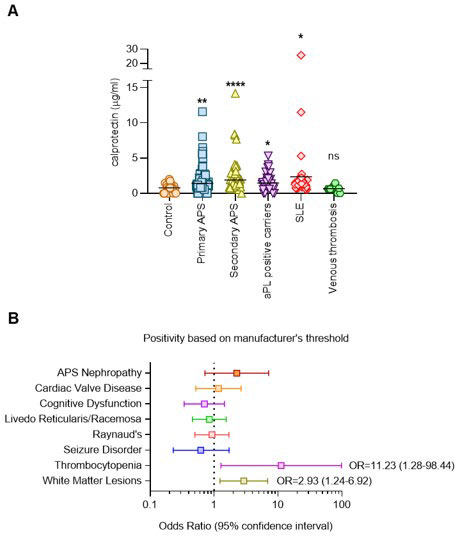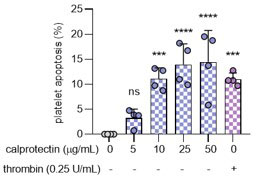Session Information
Session Type: Abstract Session
Session Time: 5:00PM-6:00PM
Background/Purpose: While thrombosis and pregnancy loss are the best-known features of APS, many patients also exhibit “non-criteria” manifestations such as thrombocytopenia and heart valve damage. Clinically actionable biomarkers that identify patients at risk for non-criteria manifestations are unavailable. Recent studies suggest that neutrophils and neutrophil extracellular traps (NETs) contribute to APS thromboinflammation and may play a role in some non-criteria manifestations. Calprotectin is a heterodimer of the alarmins S100A8 and S100A9 that is abundant in the neutrophil cytoplasm and, therefore, reliably released upon NETosis. Unlike other biomarkers of NETosis, calprotectin can be measured with widely available immunoassays. We aimed to evaluate the clinical associations and potential mechanistic role of calprotectin in antiphospholipid antibodies (aPL)-positive patients.
Methods: 237 patients were included: 113 patients with primary APS, 34 with secondary (SLE-associated) APS, 41 aPL-positive but without criteria APS manifestations, 38 with SLE without any aPL, and 11 with unprovoked venous thrombosis without any aPL. Levels of circulating calprotectin were determined in plasma by the QUANTA Flash chemiluminescent assay (Werfen). A viability dye-based platelet assay was used to assess the potential impact of calprotectin on platelet apoptosis.
Results: Elevated levels of calprotectin were detected in patients with primary and secondary APS, as well as in aPL-positive patients who lacked criteria manifestations (Fig 1A). While high levels were also observed in patients with SLE, calprotectin was not elevated in patients with unprovoked venous thrombosis without any aPL. After adjusting for age and sex, high calprotectin levels were associated with absolute neutrophil count (r=0.41, p< 0.001) and another biomarker of NETs, myeloperoxidase-DNA complexes (r=0.22, p=0.011). Levels of circulating calprotectin also tracked with CRP (r=0.41, p< 0.001) and urine protein/creatine ratio (r=0.25, p=0.006); there was a negative correlation with platelet count (r=-0.16, p=0.028). When all 188 aPL-positive patients (including those with APS) were analyzed by multivariate logistic regression, positive calprotectin was associated with brain white matter changes (OR=2.93, 95% CI 1.24-6.92) and thrombocytopenia (OR=11.23, 95% CI 1.28-98.44) (Fig 1B). Mechanistically, recombinant calprotectin triggered platelet apoptosis in a dose-dependent fashion (Fig 2).
Conclusion: In summary, these data reveal high calprotectin levels in roughly one-third of aPL-positive patients. High calprotectin associates with increased NETosis, inflammation as measured by CRP, and proteinuria. Moreover, positive testing for calprotectin identifies individuals with “non-criteria” manifestations such as thrombocytopenia and white matter changes. The role of calprotectin as a clinically actionable biomarker that might inform targeted therapy for some aPL-positive patients appears to warrant further evaluation in prospective longitudinal studies.
C. Hoy, None; N. S K, None; S. Navaz, None; S. Yalavarthi, None; C. Sarosh, None; N. Peters, None; T. Smith, None; G. Norman, Werfen; G. Figueroa Parra, None; J. Gudjonsson, None; J. Kahlenberg, AstraZeneca, Bristol-Myers Squibb(BMS), Eli Lilly, GlaxoSmithKlein(GSK), Janssen, Merck/MSD, Gilead; J. Madison, None; A. Duarte-Garcia, None; J. Knight, Jazz Pharmaceuticals, Bristol Myers Squibb; Y. Zuo, None.
To cite this abstract in AMA style:
Hoy C, S K N, Navaz S, Yalavarthi S, Sarosh C, Peters N, Smith T, Norman G, Figueroa Parra G, Gudjonsson J, Kahlenberg J, Madison J, Duarte-Garcia A, Knight J, Zuo Y. Circulating Calprotectin: A Potential New Biomarker for “Non-Criteria” Clinical Manifestations of Antiphospholipid Syndrome [abstract]. Arthritis Rheumatol. 2022; 74 (suppl 9). https://acrabstracts.org/abstract/circulating-calprotectin-a-potential-new-biomarker-for-non-criteria/. Accessed .« Back to ACR Convergence 2022
ACR Meeting Abstracts - https://acrabstracts.org/abstract/circulating-calprotectin-a-potential-new-biomarker-for-non-criteria/


